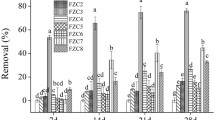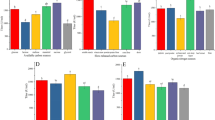Abstract
The antimicrobial activity of the metabolites produced by Fusarium oxysporum PR-33 in submerged culture was evaluated against Gram-positive and Gram-negative bacteria and yeasts. Metabolites were determined by HPLC–DAD-MS/MS. An extract was obtained following the removal of mycelium by centrifugation and lyophilisation of the supernatant. The compounds in this extract demonstrated broad-spectrum antimicrobial action, with rates of inhibition between 60 and 80%, depending on the species and extract tested. The major compounds of the extracts were identified as fusarinolic acid and its isomer [56.9% flask extract (FE)] and 59.2% bioreactor extract (BE), dehydrofusaric acid (35.7% FE and 31.6% BE), and fusaric acid (6.5% FE and 1.1% BE). Fusaric acid has been shown to be responsible for antimicrobial activity. The cytotoxicity of the extracts was evaluated in culture of HEK-293 and SH-SY5Y animal cells and toxicity of these extracts was verified even in the lowest tested concentrations. Therefore, our results indicate that the compounds identified exhibit potential as antimicrobial agents.
Graphic abstract




Similar content being viewed by others
References
Appelbaum PC (2012) 2012 and beyond: potential for the start of a second pre-antibiotic era? J Antimicrob Chemother 67:2062–2068. https://doi.org/10.1093/jac/dks213
Yu L, Wang Y, Su X et al (2020) Biodiversity, isolation and genome analysis of sulfamethazine-degrading bacteria using high-throughput analysis. Bioprocess Biosyst Eng 43:1521–1531. https://doi.org/10.1007/s00449-020-02345-1
Van Der Waaij D, Nord CE (2000) Development and persistence of multi-resistance to antibiotics in bacteria; an analysis and a new approach to this urgent problem. Int J Antimicrob Agents 16:191–197. https://doi.org/10.1016/S0924-8579(00)00227-2
De Boer W, Folman LB, Summerbell RC, Boddy L (2005) Living in a fungal world: impact of fungi on soil bacterial niche development. FEMS Microbiol Rev 29:795–811. https://doi.org/10.1016/j.femsre.2004.11.005
Conti R, Guimarães DO, Pupo MT (2012) Aprendendo com as interações da natureza: microrganismos simbiontes como fontes de produtos naturais bioativos. Cienc Cult 64:43–47. https://doi.org/10.21800/s0009-67252012000300014
Wang M, Kornsakulkarn J, Srichomthong K et al (2019) Antimicrobial anthraquinones from cultures of the ant pathogenic fungus Cordyceps morakotii BCC 56811. J Antibiot (Tokyo) 72:141–147. https://doi.org/10.1038/s41429-018-0135-y
Ganesh Kumar C, Mongolla P, Joseph J et al (2010) Activité antimicrobienne d’extraits d’isolats fongiques du sol et du fumier du parc national de Kaziranga, Assam, Inde. J Mycol Med 20:283–289. https://doi.org/10.1016/j.mycmed.2010.08.002
Khan AA, Bacha N, Ahmad B et al (2014) Fungi as chemical industries and genetic engineering for the production of biologically active secondary metabolites. Asian Pac J Trop Biomed 4:859–870. https://doi.org/10.12980/APJTB.4.2014APJTB-2014-0230
Dutreix L, Bernard C, Juin C et al (2018) Do raspberry extracts and fractions have antifungal or anti-adherent potential against Candida spp.? Int J Antimicrob Agents 52:947–953. https://doi.org/10.1016/j.ijantimicag.2018.08.020
Ren D, Zhao Y, Nie Y et al (2014) Chemical composition of Pleurotus eryngii polysaccharides and their inhibitory effects on high-fructose diet-induced insulin resistance and oxidative stress in mice. Food Funct 5:2609–2620. https://doi.org/10.1039/c3fo60640f
Manganyi MC, Regnier T, Olivier EI (2015) Antimicrobial activities of selected essential oils against Fusarium oxysporum isolates and their biofilms. South African J Bot 99:115–121. https://doi.org/10.1016/j.sajb.2015.03.192
Hussain H, Drogies KH, Al-Harrasi A et al (2015) Antimicrobial constituents from endophytic fungus Fusarium sp. Asian Pacific J Trop Dis 5:186–189. https://doi.org/10.1016/S2222-1808(14)60650-2
Tao S, Peng L, Beihui L et al (1998) Successive cultivation of Fusarium oxysporum on rice chaff for economic production of fibrinolytic enzyme. Bioprocess Eng 18:379–381. https://doi.org/10.1007/s004490050459
Almeida ÉS, de Oliveira D, Hotza D (2017) Characterization of silver nanoparticles produced by biosynthesis mediated by Fusarium oxysporum under different processing conditions. Bioprocess Biosyst Eng 40:1291–1303. https://doi.org/10.1007/s00449-017-1788-9
Kuhad RC, Manchanda M, Singh A (1999) Hydrolytic potential of extracellular enzymes from a mutant strain of Fusarium oxysporum. Bioprocess Eng 20:133–135. https://doi.org/10.1007/s004490050571
Gambato G, Todescato K, Pavão EM et al (2016) Evaluation of productivity and antioxidant profile of solid-state cultivated macrofungi Pleurotus albidus and Pycnoporus sanguineus. Bioresour Technol 207:46–51. https://doi.org/10.1016/J.BIORTECH.2016.01.121
Camassola M, da Rosa LO, Calloni R et al (2013) Secretion of laccase and manganese peroxidase by Pleurotus strains cultivate in solid-state using Pinus spp. sawdust. Brazilian J Microbiol 44:207–213. https://doi.org/10.1590/S1517-83822013005000006
Rodrigues E, Mariutti LRB, Mercadante AZ (2013) Carotenoids and phenolic compounds from Solanum sessiliflorum, an unexploited amazonian fruit, and their scavenging capacities against reactive oxygen and nitrogen species. J Agric Food Chem 61:3022–3029. https://doi.org/10.1021/jf3054214
Schuh RS, Poletto É, Fachel FNS et al (2018) Physicochemical properties of cationic nanoemulsions and liposomes obtained by microfluidization complexed with a single plasmid or along with an oligonucleotide: Implications for CRISPR/Cas technology. J Colloid Interface Sci 530:243–255. https://doi.org/10.1016/j.jcis.2018.06.058
Zhang H, Sun X, Xu C (2016) Antimicrobial activity of endophytic fungus Fusarium sp. isolated from medicinal honeysuckle plant. Arch Biol Sci 68:25–30. https://doi.org/10.2298/ABS140401004Z
Musavi SF, Balakrishnan RM (2014) A Study on the Antimicrobial Potentials of an Endophytic Fungus Fusarium oxysporum NFX 06. J Med Bioeng 3:162–166. https://doi.org/10.12720/jomb.3.3.162-166
Bacon CW, Porter JK, Norred WP, Leslie JF (1996) Production of fusaric acid by Fusarium species. Appl Environ Microbiol 62:4039–4043. https://doi.org/10.1128/aem.62.11.4039-4043.1996
Wang H, Ng TB (1999) Pharmacological activities of fusaric acid (5-butylpicolinic acid). Life Sci 65:849–856. https://doi.org/10.1016/S0024-3205(99)00083-1
Hldaka H, Nagatsu T, Takeya K et al (1969) Fusaric acid, a hypotensive agent produced by fungi. J Antibiot (Tokyo) 22:228–230. https://doi.org/10.7164/antibiotics.22.228
Li X, Zhang ZL, Wang HF (2017) Fusaric acid (FA) protects heart failure induced by isoproterenol (ISP) in mice through fibrosis prevention via TGF-β1/SMADs and PI3K/AKT signaling pathways. Biomed Pharmacother 93:130–145. https://doi.org/10.1016/j.biopha.2017.06.002
Sondergaard TE, Fredborg M, Oppenhagen Christensen AM et al (2016) Fast screening of antibacterial compounds from Fusaria. Toxins (Basel) 8:1–9. https://doi.org/10.3390/toxins8120355
Li J, Sun W, Guo Z et al (2014) Fusaric acid modulates Type Three Secretion System of Salmonella enterica serovar Typhimurium. Biochem Biophys Res Commun 449:455–459. https://doi.org/10.1016/j.bbrc.2014.05.044
Gashgari R, Gherbawy Y, Ameen F, Alsharari S (2016) Molecular characterization and analysis of antimicrobial activity of endophytic fungi from medicinal plants in Saudi Arabia. Jundishapur J Microbiol 9:1–8. https://doi.org/10.5812/jjm.26157
Tchoukoua A, Hasegawa R, Hendracipta KA et al (2018) Structure elucidation of new fusarielins from Fusarium sp. and their antimicrobial activity. Magn Reson Chem 56:32–36. https://doi.org/10.1002/mrc.4662
Shen HS, Shao S, Chen JC, Zhou T (2017) Antimicrobials from mushrooms for assuring food safety. Compr Rev Food Sci Food Saf 16:316–329. https://doi.org/10.1111/1541-4337.12255
Amalfitano C, Pengue R, Andolfi A et al (2002) HPLC analysis of fusaric acid, 9,10-dehydrofusaric acid and their methyl esters, toxic metabolites from weed pathogenic Fusarium species. Phytochem Anal 13:277–282. https://doi.org/10.1002/pca.648
Shinde SB, Deshmukh HV (2014) Estimation of fusaric acid from culture filtrate of Fusarium udum by thin layer chromatography. Asian J Bio Sci 9:251–254. https://doi.org/10.15740/has/ajbs/9.2/251-254
Tung TT, Jakobsen TH, Dao TT et al (2017) Fusaric acid and analogues as Gram-negative bacterial quorum sensing inhibitors. Eur J Med Chem 126:1011–1020. https://doi.org/10.1016/j.ejmech.2016.11.044
Sheik Abdul N, Nagiah S, Chuturgoon AA (2016) Fusaric acid induces mitochondrial stress in human hepatocellular carcinoma (HepG2) cells. Toxicon 119:336–344. https://doi.org/10.1016/j.toxicon.2016.07.002
Mamur S, Ünal F, Yılmaz S et al (2020) Evaluation of the cytotoxic and genotoxic effects of mycotoxin fusaric acid. Drug Chem Toxicol 43:149–157. https://doi.org/10.1080/01480545.2018.1499772
Acknowledgements
This study was supported by grants from Conselho Nacional de Desenvolvimento Científico e Tecnológico (CNPq 472153/2013-7 and 310255/2012-0), Fundação de Amparo à Pesquisa do Estado do Rio Grande do Sul (FAPERGS 16/2551-0000246-0), and Coordenação de Apoio de Pessoal de Nível Superior (CAPES3255/2013).
Author information
Authors and Affiliations
Corresponding author
Ethics declarations
Conflict of interest
The authors delcare that they have no conflict of interest.
Additional information
Publisher's Note
Springer Nature remains neutral with regard to jurisdictional claims in published maps and institutional affiliations.
Rights and permissions
About this article
Cite this article
Poleto, L., da Rosa, L.O., Fontana, R.C. et al. Production of antimicrobial metabolites against pathogenic bacteria and yeasts by Fusarium oxysporum in submerged culture processes. Bioprocess Biosyst Eng 44, 1321–1332 (2021). https://doi.org/10.1007/s00449-021-02538-2
Received:
Accepted:
Published:
Issue Date:
DOI: https://doi.org/10.1007/s00449-021-02538-2




